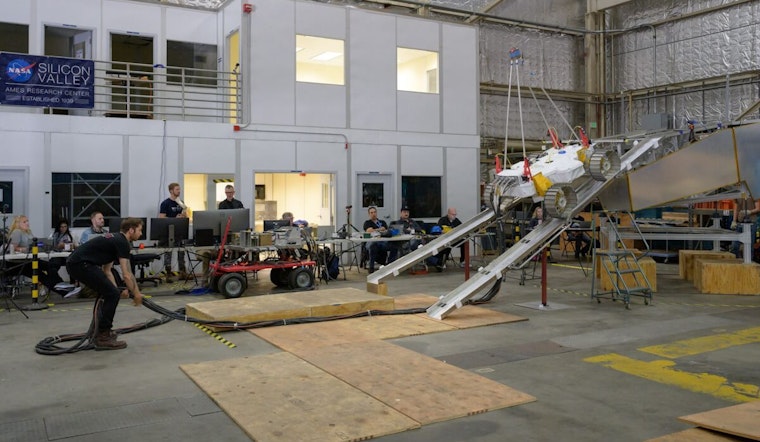
Last week, NASA's Volatiles Investigating Polar Exploration Rover (VIPER) underwent critical testing as it practiced descending from a mock lunar lander ramp at Ames Research Center in Silicon Valley. CBS Bay Area reported, that this mobile robot, destined for the Moon's south pole in search of water, is set for a groundbreaking space mission. Demonstrating its ability to smoothly exit the lander on the lunar surface is crucial for the rover.
SpaceX's Falcon Heavy launch vehicle and Astrobotic's Griffin lander will transport VIPER to the Moon's surface, while drivers at Ames will remotely control the rover. The tests conducted at the Ames Research Center aimed to simulate various challenging scenarios that the rover might face when it exits the lander on the Moon, such as uneven ramps and steep inclines. According to Mercedes Herreras Martinez, the mission's risk manager, making sure the rover's wheels have a good grip and can adjust to different lander alignments is essential for safely traversing lunar terrain.
In recent trials, VIPER overcame several worst-case scenarios related to pitch and roll during the egress (exiting the lander) process, according to NASA. The tests incorporated different configurations for the lunar lander's ramps, which are designed to vary substantially depending on the condition of the lunar terrain upon the lander's arrival at its destination, Mons Mouton near the Moon's South Pole. VIPER’s systems faced some of the most strenuous conditions, inspiring confidence in the rover's ability to perform effectively during its actual mission.
Completion of these tests indicates the successful progress of VIPER’s lunar mission, which involves creating a resource map of the Moon's water and other resources, essential for future lunar base building and prolonged human presence on the Moon. As ABC7 reported, the rover will be equipped with three spectrometers and a drill to analyze ice samples at various depths and concentrations on the Moon, providing new insights into the lunar environment.
Previous egress tests at NASA's Ames Research Center have shed light on the challenges VIPER could encounter during its mission, generating valuable insights for the rover's development. Rusty Hunt, Flight Director for VIPER, revealed that each egress test had offered new lessons, and they were learning from different driving simulations to prepare the rover for its landing on the lunar surface. He explains that the rover will be parked in hibernation mode during lunar nights, resuming activity when the sun rises again.
Communication between ground control and the rover will be critical to success. Mercedes Herreras Martinez elaborates that radio signals can be easily interrupted, causing interference, due to Earth's low position on the Moon's South Pole horizon. Engineers are working tirelessly to address these challenges and ensure the rover's communication with ground control remains robust and uninterrupted during the mission.
As VIPER continues to conquer increasingly complex tests, the mission moves closer to its scheduled launch in late 2024 from Cape Canaveral. The final flight build of Astrobotic's Griffin lander, which will transfer VIPER to the Moon's surface, is currently under construction in Pittsburgh, Pennsylvania, according to Alivia Chapla, Astrobotic's Marketing Director. With two ramps on either side of the Griffin lander, VIPER will have safer egress options depending on the landing site's lunar terrain.
NASA's first-ever robotic Moon rover signifies an important milestone for space exploration, as support from both parties in Congress has maintained a bipartisan consensus. San Jose Congresswoman Zoe Lofgren mentions, "We're going to go to asteroids, we're going to go to Mars. It's really the beginning of mankind moving out into space, and at the center of it is NASA." As VIPER's development moves steadfastly forward, the possibility of uncovering more mysteries about the Moon and our universe comes even closer to reality.



-1.webp?w=1000&h=1000&fit=crop&crop:edges)
-2.webp?w=1000&h=1000&fit=crop&crop:edges)




